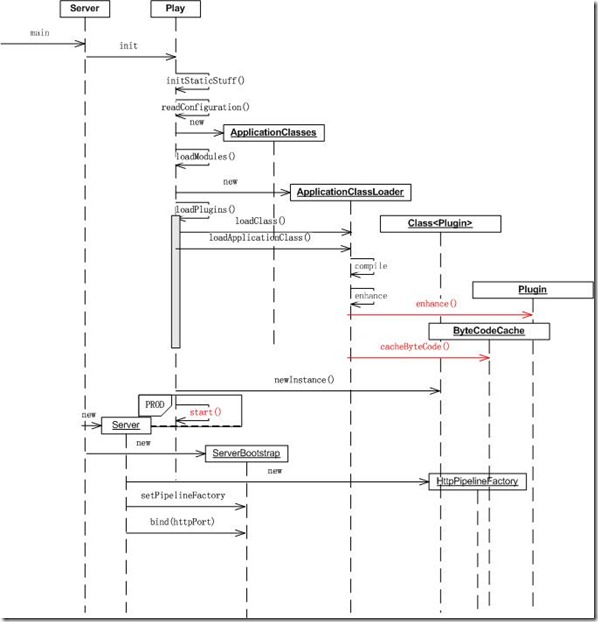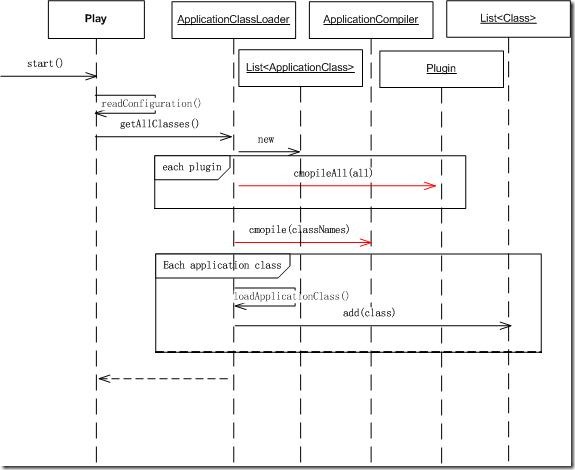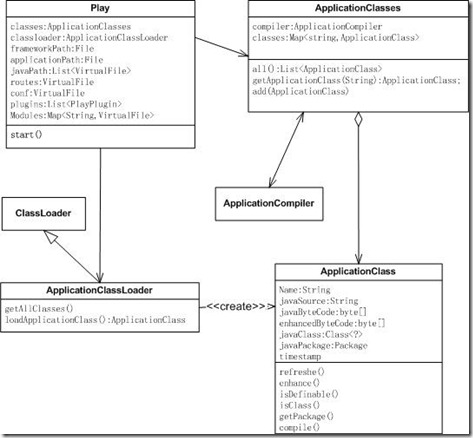Play是个Rails风格的Java Web框架,需要了解背景请看:
- Play Framework介绍1--主要概念
- Play Framework介绍2—Helloworld
如何调试请看此处。以下进入正题^_^
Server启动过程主要涉及三个地方:
- play.Play类:代表Play本身业务模型。
- play.server.Server类:负责服务器启动。
- play.classloading包:负责.java文件读取、编译和加载。
总体流程:

Server.main为入口方法:
public static void main(String[] args) throws Exception {
…
Play.init(root, System.getProperty("play.id", ""));
if (System.getProperty("precompile") == null) {
new Server();
} else {
Logger.info("Done.");
}
}
做两件事:
- Play.init
- 然后创建Server对象。
Play.init
public static void init(File root, String id) {
…
readConfiguration();
Play.classes = new ApplicationClasses();
…
// Build basic java source path
VirtualFile appRoot = VirtualFile.open(applicationPath);
roots.add(appRoot);
javaPath = new ArrayList<VirtualFile>(2);
javaPath.add(appRoot.child("app"));
javaPath.add(appRoot.child("conf"));
// Build basic templates path
templatesPath = new ArrayList<VirtualFile>(2);
templatesPath.add(appRoot.child("app/views"));
// Main route file
routes = appRoot.child("conf/routes");
…
// Load modules
loadModules();
…
// Enable a first classloader
classloader = new ApplicationClassloader();
// Plugins
loadPlugins();
// Done !
if (mode == Mode.PROD ||preCompile() ) {
start();
}
…
}
主要做:
- 加载配置
- new ApplicationClasses();加载app、views和conf路径到VirtualFile中,VirtualFile是Play内部的统一文件访问接口,方便后续读取文件
- 加载route
- 加载Module,Play的应用扩展组件。
- 加载Plugin,Play框架自身的扩展组件。
- 工作在产品模式则启动Play.
关键步骤为new ApplicationClasses(),执行computeCodeHashe(),后者触发目录扫描,搜索.java文件。相关过程简化代码如下:
public ApplicationClassloader() {
super(ApplicationClassloader.class.getClassLoader());
// Clean the existing classes
for (ApplicationClass applicationClass : Play.classes.all()) {
applicationClass.uncompile();
}
pathHash = computePathHash();
…
}
int computePathHash() {
StringBuffer buf = new StringBuffer();
for (VirtualFile virtualFile : Play.javaPath) {
scan(buf, virtualFile);
}
return buf.toString().hashCode();
}
void scan(StringBuffer buf, VirtualFile current) {
if (!current.isDirectory()) {
if (current.getName().endsWith(".java")) {
Matcher matcher = Pattern.compile("\\s+class\\s([a-zA-Z0-9_]+)\\s+").matcher(current.contentAsString());
buf.append(current.getName());
buf.append("(");
while (matcher.find()) {
buf.append(matcher.group(1));
buf.append(",");
}
buf.append(")");
}
} else if (!current.getName().startsWith(".")) {
for (VirtualFile virtualFile : current.list()) {
scan(buf, virtualFile);
}
}
}
Start流程

简化代码如下:
public static synchronized void start() {
try {
...
// Reload configuration
readConfiguration();
...
// Try to load all classes
Play.classloader.getAllClasses();
// Routes
Router.detectChanges(ctxPath);
// Cache
Cache.init();
// Plugins
for (PlayPlugin plugin : plugins) {
try {
plugin.onApplicationStart();
} catch(Exception e) {
if(Play.mode.isProd()) {
Logger.error(e, "Can't start in PROD mode with errors");
}
if(e instanceof RuntimeException) {
throw (RuntimeException)e;
}
throw new UnexpectedException(e);
}
}
...
// Plugins
for (PlayPlugin plugin : plugins) {
plugin.afterApplicationStart();
}
} catch (PlayException e) {
started = false;
throw e;
} catch (Exception e) {
started = false;
throw new UnexpectedException(e);
}
}
关键步骤为执行Play.classloader.getAllClasses()加载app目录中的类型。简化代码如下:
public List<Class> getAllClasses() {
if (allClasses == null) {
allClasses = new ArrayList<Class>();
if (Play.usePrecompiled) {
...
} else {
List<ApplicationClass> all = new ArrayList<ApplicationClass>();
// Let's plugins play
for (PlayPlugin plugin : Play.plugins) {
plugin.compileAll(all);
}
for (VirtualFile virtualFile : Play.javaPath) {
all.addAll(getAllClasses(virtualFile));
}
List<String> classNames = new ArrayList<String>();
for (int i = 0; i < all.size(); i++) {
if (all.get(i) != null && !all.get(i).compiled) {
classNames.add(all.get(i).name);
}
}
Play.classes.compiler.compile(classNames.toArray(new String[classNames.size()]));
for (ApplicationClass applicationClass : Play.classes.all()) {
Class clazz = loadApplicationClass(applicationClass.name);
if (clazz != null) {
allClasses.add(clazz);
}
}
...
}
}
return allClasses;
}
主要步骤:
- plugin.compileAll,给所有plugin一次机会进行自定义编译。
- Play.classes.compiler.compile(classNames.toArray(new String[classNames.size()]));编译所有.java文件。编译后的.class存储在ApplicationClass中。内部使用了eclipse的JDT编译器。
- loadApplicationClass,取出ApplicationClass中的.class加入List中返回。
到此完成.java的加载。相关对象关系如下图:

接着new Server()启动HTTP服务,监听请求
简化代码如下:
public Server() {
...
if (httpPort == -1 && httpsPort == -1) {
httpPort = 9000;
}
...
InetAddress address = null;
try {
if (p.getProperty("http.address") != null) {
address = InetAddress.getByName(p.getProperty("http.address"));
} else if (System.getProperties().containsKey("http.address")) {
address = InetAddress.getByName(System.getProperty("http.address"));
}
} catch (Exception e) {
Logger.error(e, "Could not understand http.address");
System.exit(-1);
}
ServerBootstrap bootstrap = new ServerBootstrap(new NioServerSocketChannelFactory(
Executors.newCachedThreadPool(), Executors.newCachedThreadPool())
);
try {
if (httpPort != -1) {
bootstrap.setPipelineFactory(new HttpServerPipelineFactory());
bootstrap.bind(new InetSocketAddress(address, httpPort));
bootstrap.setOption("child.tcpNoDelay", true);
if (Play.mode == Mode.DEV) {
if (address == null) {
Logger.info("Listening for HTTP on port %s (Waiting a first request to start) ...", httpPort);
} else {
Logger.info("Listening for HTTP at %2$s:%1$s (Waiting a first request to start) ...", httpPort, address);
}
} else {
if (address == null) {
Logger.info("Listening for HTTP on port %s ...", httpPort);
} else {
Logger.info("Listening for HTTP at %2$s:%1$s ...", httpPort, address);
}
}
}
} catch (ChannelException e) {
Logger.error("Could not bind on port " + httpPort, e);
System.exit(-1);
}
...
}
主要步骤:
- 设置端口,地址
- new ServerBootstrap,创建jboss netty服务器。Play1.1.1使用了netty作为底层通讯服务器。
- new HttpServerPipelineFactory(),设置netty所需的请求处理管道工厂。它负责当请求到达时提供处理者。
- bootstrap.bind(new InetSocketAddress(address, httpPort),绑定地址,端口。
到此万事具备,只等东风了…